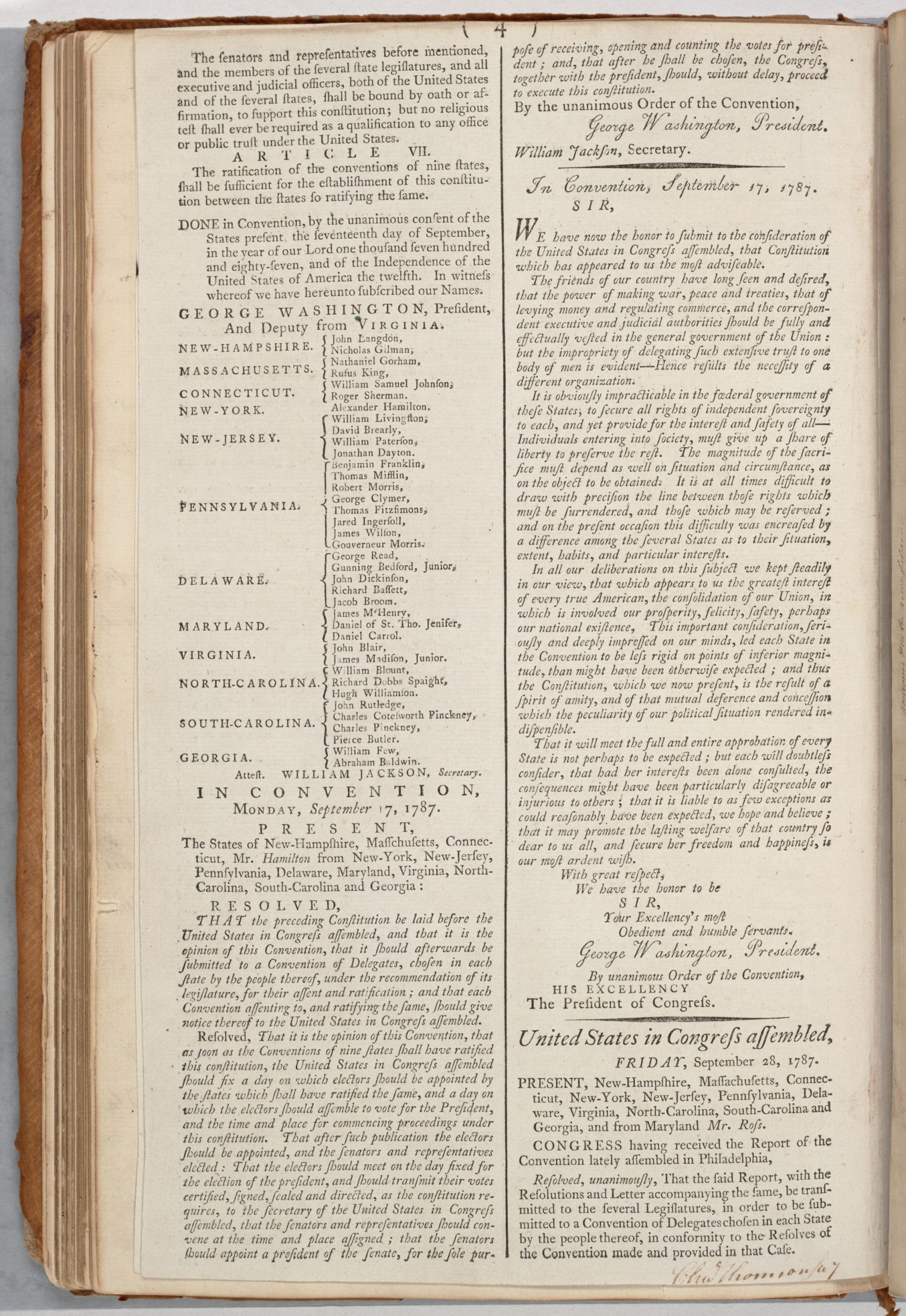We the People: Elementary Edition
Focusing on Details: Compare and Contrast
All documents and text associated with this activity are printed below, followed by a worksheet for student responses.Introduction
Here you will see two versions of the United States Constitution:- A draft printed early in the Constitutional Convention
- A version printed several months later with the final approved text
The first section of both of these documents is known as the Preamble. Between the first draft and the final version, many edits occurred throughout the entire Constitution — but perhaps most notable was in the Preamble itself.
Notice the differences between the two versions of the Preamble and answer the questions below.
Note: Both versions of the printed Preamble use a now-antiquated version of a long s (ſ) that appears similar to a lowercase f.
Name:
Class:
Class:
Worksheet
We the People: Elementary Edition
Focusing on Details: Compare and Contrast
Examine the documents included in this activity and write your response in the space provided.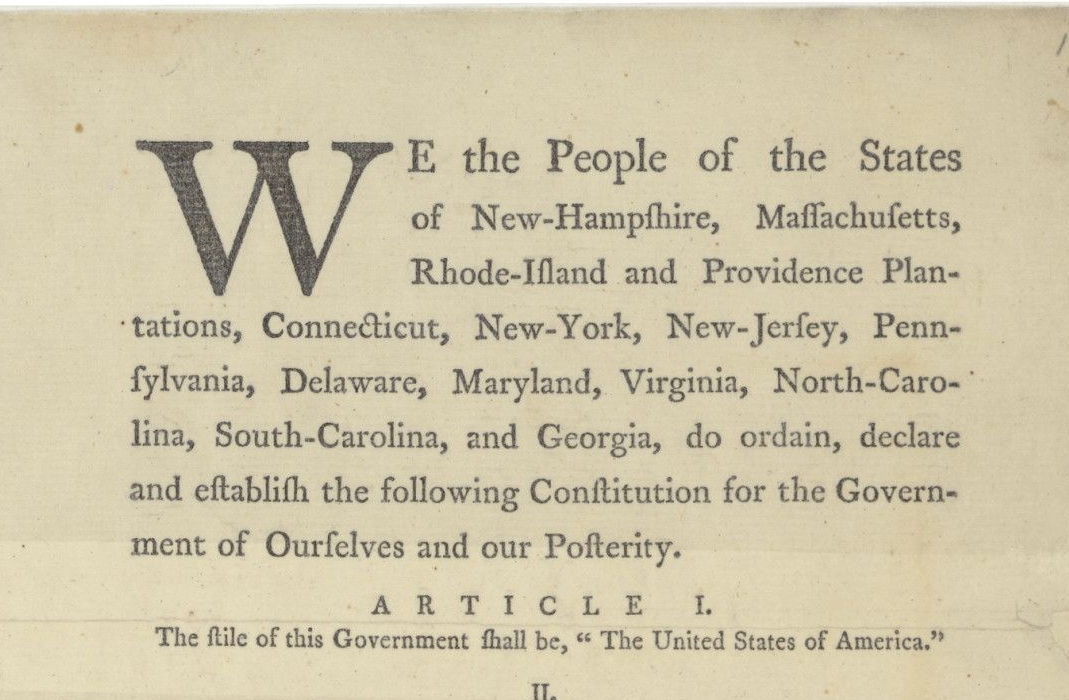
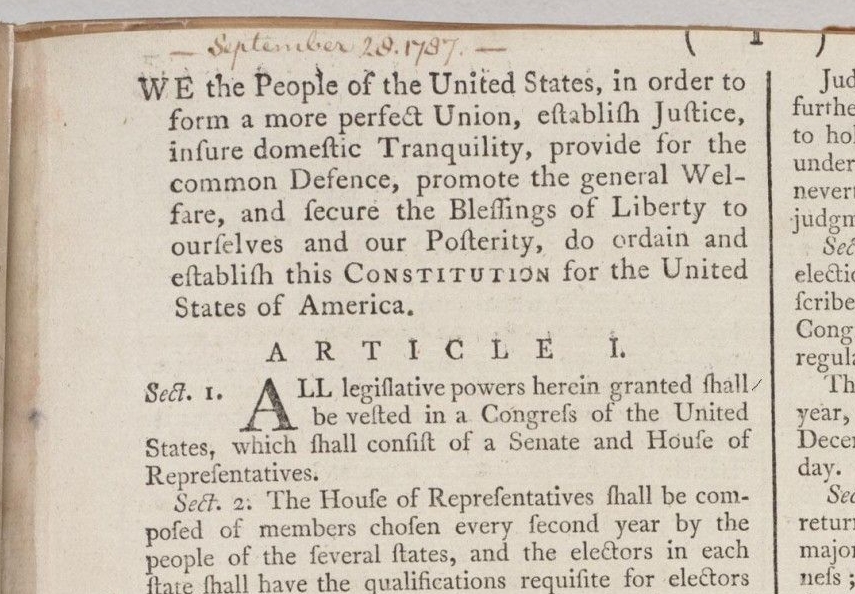
- What are the major differences between the draft of the Preamble and the final version?
- Why do you think the wording was changed?
- How do these differences help explain the purpose of the Constitution?
- What words added to the Preamble suggest the need for building a unified American community?
Your Response
1
Activity Element
George Washington`s Annotated Copy of a Draft of the U.S. Constitution

2
Activity Element
[Printed version of the United States Constitution] Resolve Book of the Office of Foreign Affairs

Conclusion
We the People: Elementary Edition
Focusing on Details: Compare and Contrast
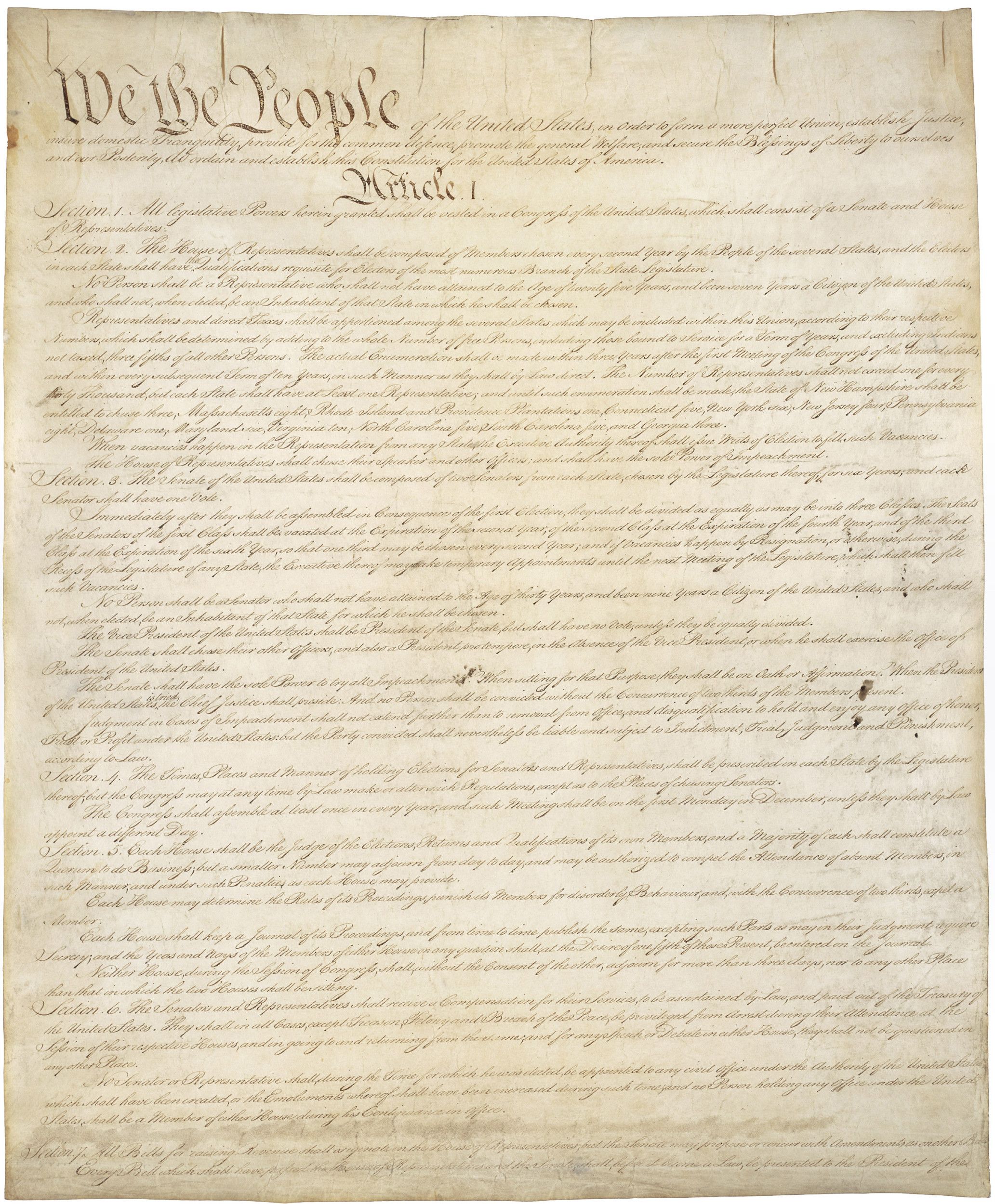 Rewrite the words in the Preamble to make it more understandable to students one grade below yours. Help them understand the purpose of the Federal government as outlined here.
Rewrite the words in the Preamble to make it more understandable to students one grade below yours. Help them understand the purpose of the Federal government as outlined here.Go through the Preamble line-by-line and rewrite each line:
- We the people, of the United States,
- in Order to form a more perfect Union,
- establish Justice,
- insure domestic Tranquility,
- provide for the common defense,
- promote the general Welfare,
- and secure the Blessings of Liberty to ourselves and our Posterity,
- do ordain and establish this Constitution for the United States of America.
Think about which words the students won't understand. If needed, use a dictionary or thesaurus to find more age-appropriate words.
Your Response
Document
George Washington's Annotated Copy of a Draft of the U.S. Constitution
8/6/1787
On Monday, July 23, 1787, nearly two months after the Constitutional Convention began in Philadelphia, delegates established a Committee of Detail. Committee members included chairman John Rutledge (SC), Nathaniel Gorham (MA), Oliver Ellsworth (CT), Edmund Randolph (VA), and James Wilson (PA). Their job was to prepare a report and a printed draft of a Constitution “conformable to the proceedings of the convention.” In other words, they were to bring some sort of order to the resolutions that had been approved to date.
Two weeks later, on August 6, the committee submitted a printed rough draft to the delegates for their consideration. In this draft, the Preamble began, as the Articles of Confederation had, with a list of the 13 states in order from north to south. It read:
On September 8, the delegates appointed a final committee, the Committee of Style, comprised of Chairman William Samuel Johnson (CT), Alexander Hamilton (NY), James Madison (VA), Rufus King (MA), and Gouverneur Morris (PA), to “revise the stile [sic] of and arrange the articles which have been agreed to by the House.”
Just four days later, the committee submitted its draft to the convention. In this draft, the Preamble had undergone major changes—primarily at the hand of Gouverneur Morris. First, rather than listing each of the states individually, now the charter began with “We the People of the United States.” The state names were omitted in part because the delegates did not know which states would ratify the Constitution, and future states were expected to join. This change also strengthened the idea of popular sovereignty—that the new government’s power came from the people rather than the states.
Second, the Preamble had expanded from 44 words that simply introduced the document, to a total of 52 words that not only explained the document’s intention, which was to establish a new government for the United States, but eloquently articulated the purposes of that new government. Those purposes included establishing justice, insuring domestic tranquility, providing for the common defense, promoting general welfare, and securing the blessings of liberty.
On September 15, the delegates were in agreement and ordered that a final draft be engrossed on parchment. On September 17, thirty-nine delegates signed the Constitution and sent it to Congress for its approval, before it would be sent to the states for their ratification.
Text adapted from "George Washington’s Printed Draft of the Constitution and Mike Wilkins’s Preamble" (May/June 2009) in the National Council for the Social Studies (NCSS) publication Social Education.
Two weeks later, on August 6, the committee submitted a printed rough draft to the delegates for their consideration. In this draft, the Preamble began, as the Articles of Confederation had, with a list of the 13 states in order from north to south. It read:
We the People of the States of New Hampshire, Massachusetts, Rhode Island and Providence Plantation, Connecticut, New York, New Jersey, Pennsylvania, Delaware, Maryland, Virginia, North Carolina, South Carolina, and Georgia, do ordain, declare and establish the following Constitution for the Government of Ourselves and our Posterity.This document is George Washington’s copy of the draft, showing his handwritten notes. Serving as the president of the convention, he annotated his copy, as did the other delegates, reflecting the discussion and noting changes proposed during the next five weeks.
On September 8, the delegates appointed a final committee, the Committee of Style, comprised of Chairman William Samuel Johnson (CT), Alexander Hamilton (NY), James Madison (VA), Rufus King (MA), and Gouverneur Morris (PA), to “revise the stile [sic] of and arrange the articles which have been agreed to by the House.”
Just four days later, the committee submitted its draft to the convention. In this draft, the Preamble had undergone major changes—primarily at the hand of Gouverneur Morris. First, rather than listing each of the states individually, now the charter began with “We the People of the United States.” The state names were omitted in part because the delegates did not know which states would ratify the Constitution, and future states were expected to join. This change also strengthened the idea of popular sovereignty—that the new government’s power came from the people rather than the states.
Second, the Preamble had expanded from 44 words that simply introduced the document, to a total of 52 words that not only explained the document’s intention, which was to establish a new government for the United States, but eloquently articulated the purposes of that new government. Those purposes included establishing justice, insuring domestic tranquility, providing for the common defense, promoting general welfare, and securing the blessings of liberty.
On September 15, the delegates were in agreement and ordered that a final draft be engrossed on parchment. On September 17, thirty-nine delegates signed the Constitution and sent it to Congress for its approval, before it would be sent to the states for their ratification.
Text adapted from "George Washington’s Printed Draft of the Constitution and Mike Wilkins’s Preamble" (May/June 2009) in the National Council for the Social Studies (NCSS) publication Social Education.
This primary source comes from the Records of the Continental and Confederation Congresses and the Constitutional Convention.
National Archives Identifier: 1501555
Full Citation: George Washington's Annotated Copy of a Draft of the U.S. Constitution; 8/6/1787; Official Records of the Constitutional Convention of 1787; Records of the Continental and Confederation Congresses and the Constitutional Convention, ; National Archives Building, Washington, DC. [Online Version, https://docsteach.org/documents/document/washington-annotated-draft-constitution, April 16, 2024]George Washington's Annotated Copy of a Draft of the U.S. Constitution
Page 1
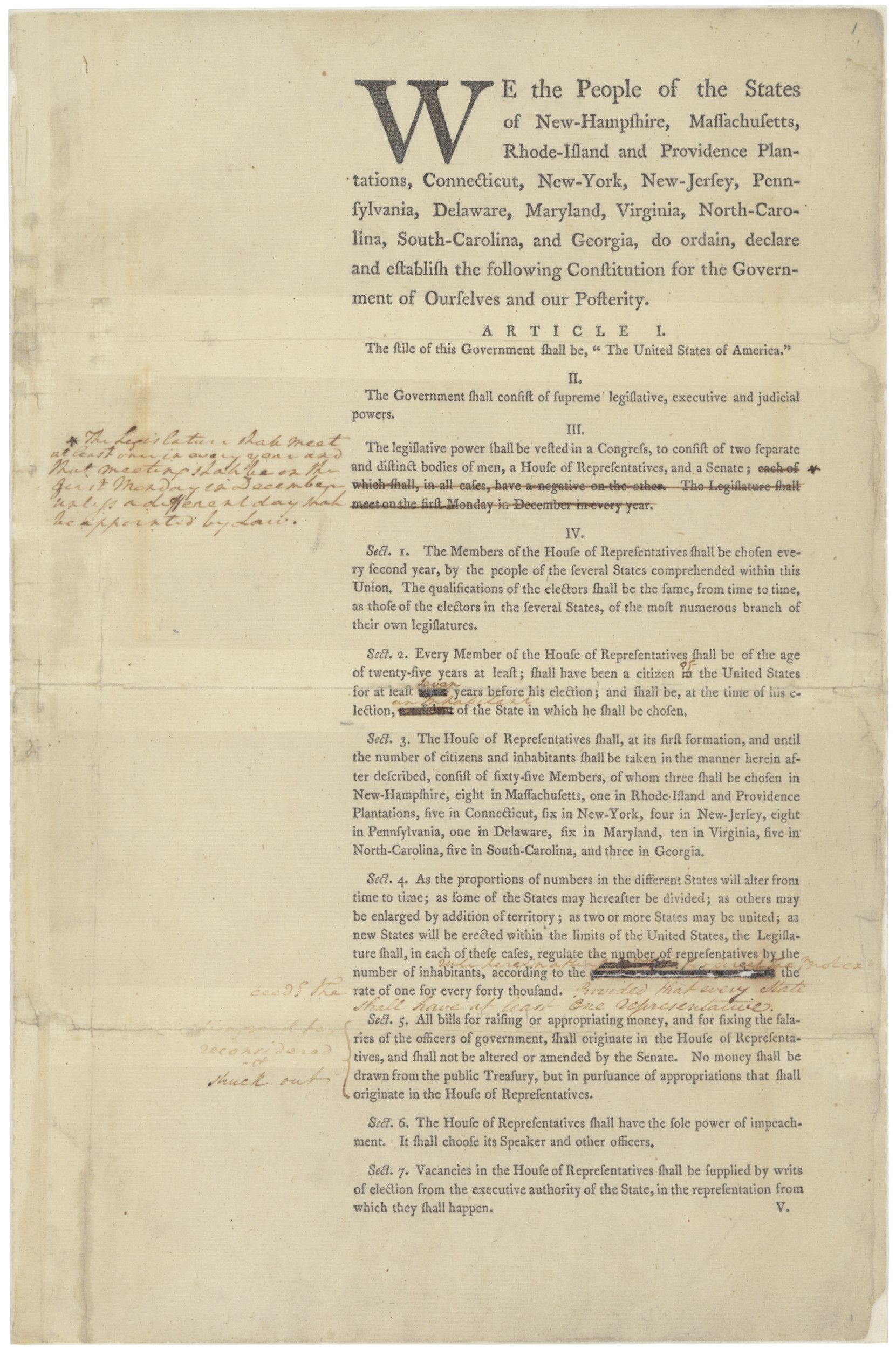
George Washington's Annotated Copy of a Draft of the U.S. Constitution
Page 2
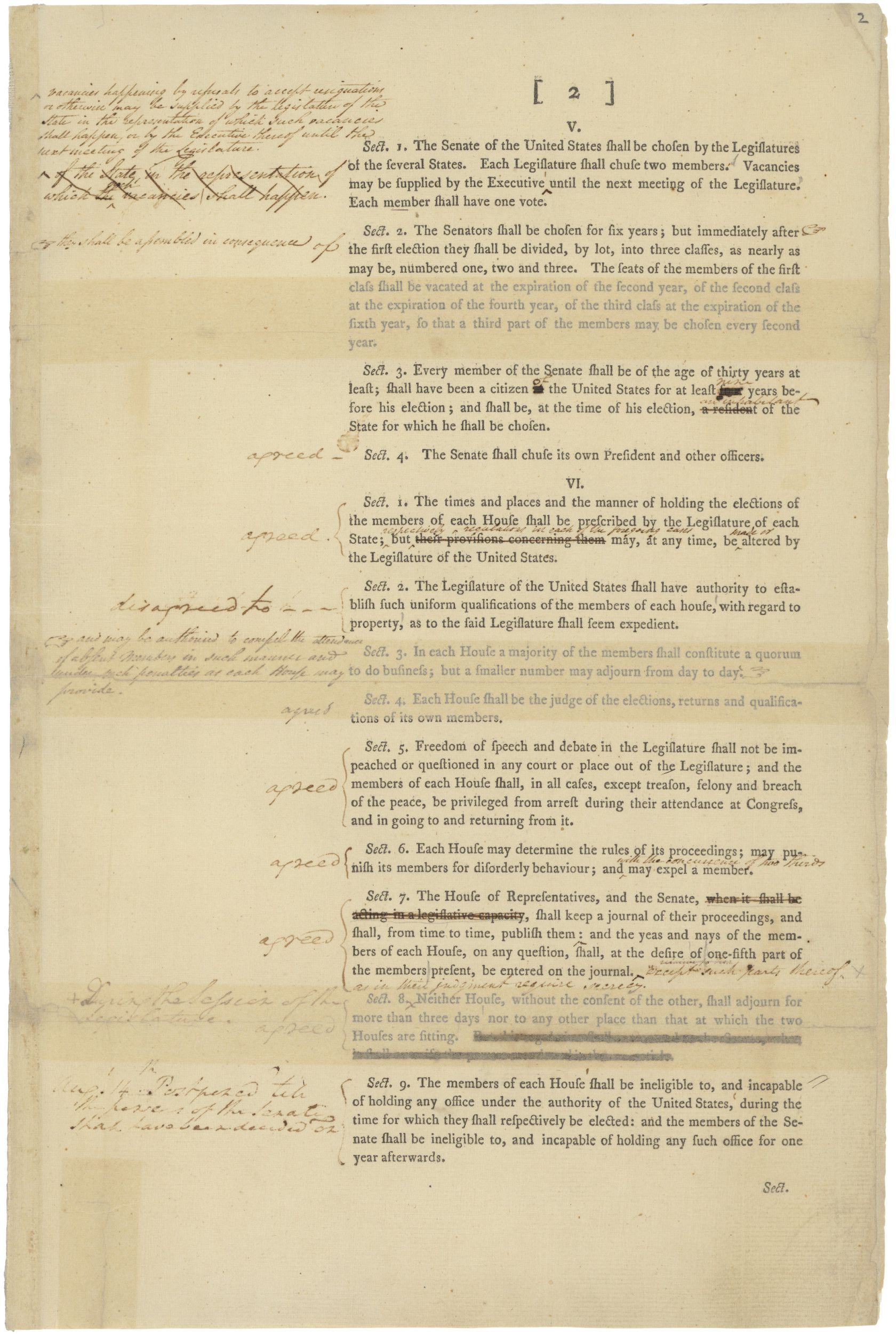
George Washington's Annotated Copy of a Draft of the U.S. Constitution
Page 3
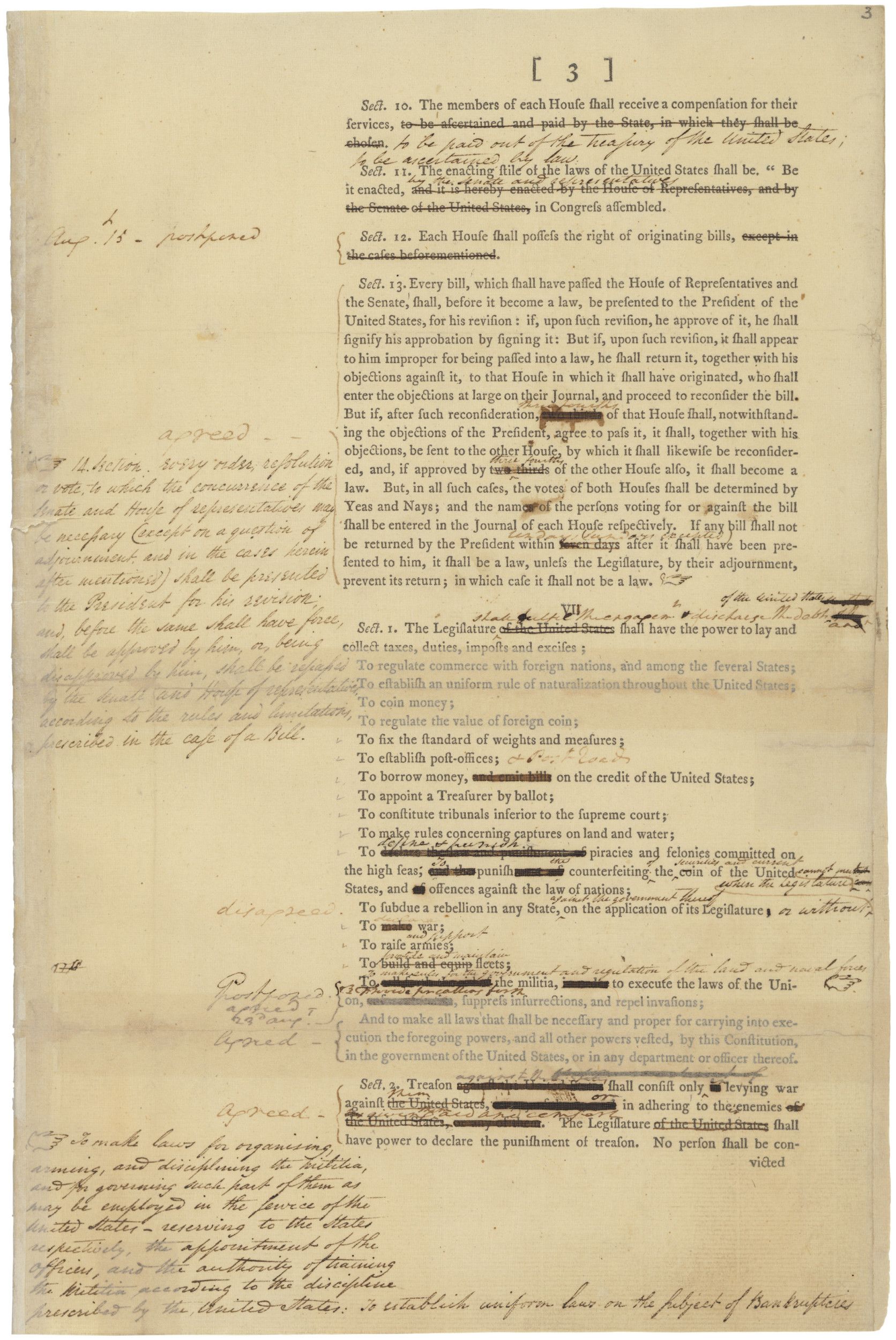
George Washington's Annotated Copy of a Draft of the U.S. Constitution
Page 4
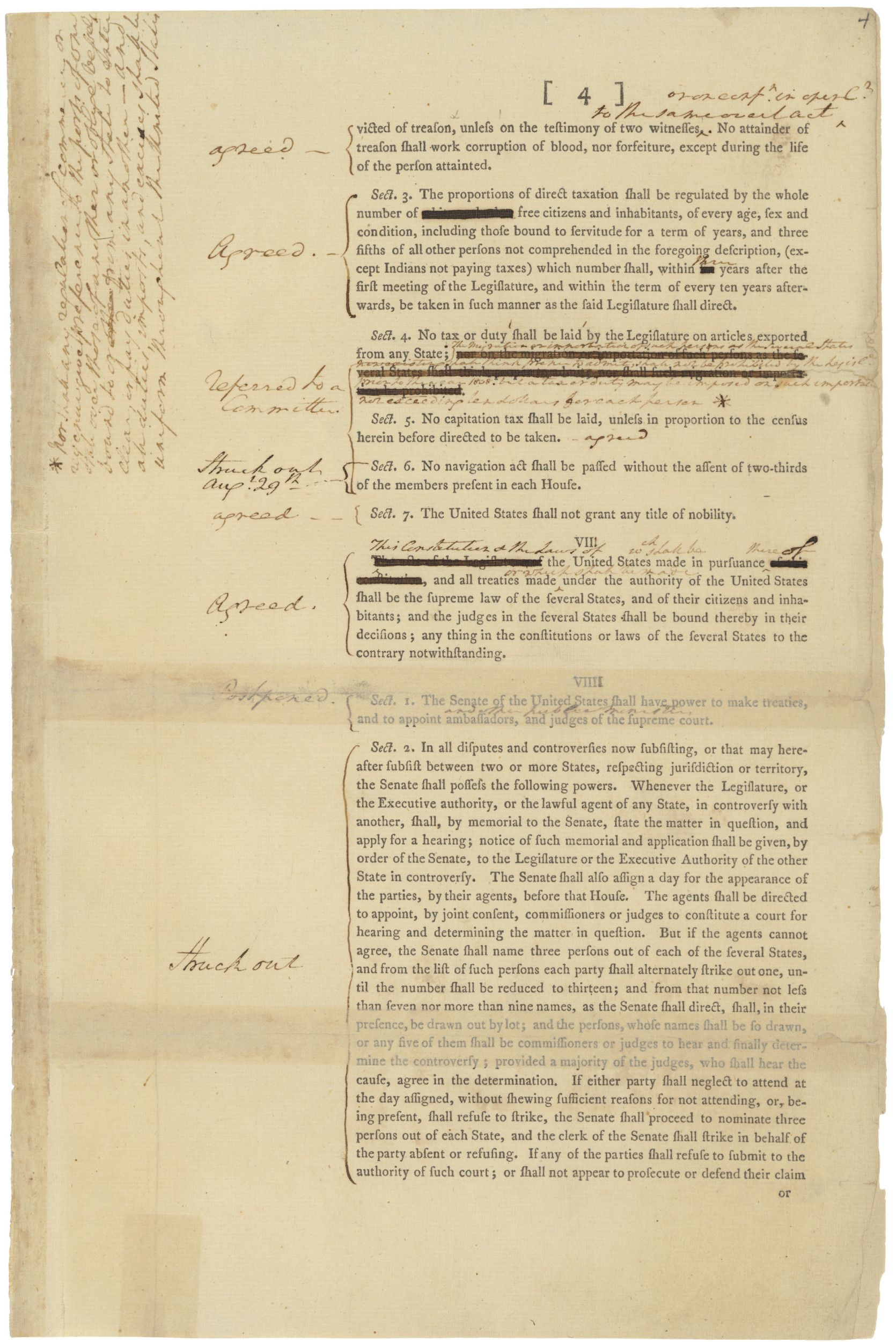
George Washington's Annotated Copy of a Draft of the U.S. Constitution
Page 5
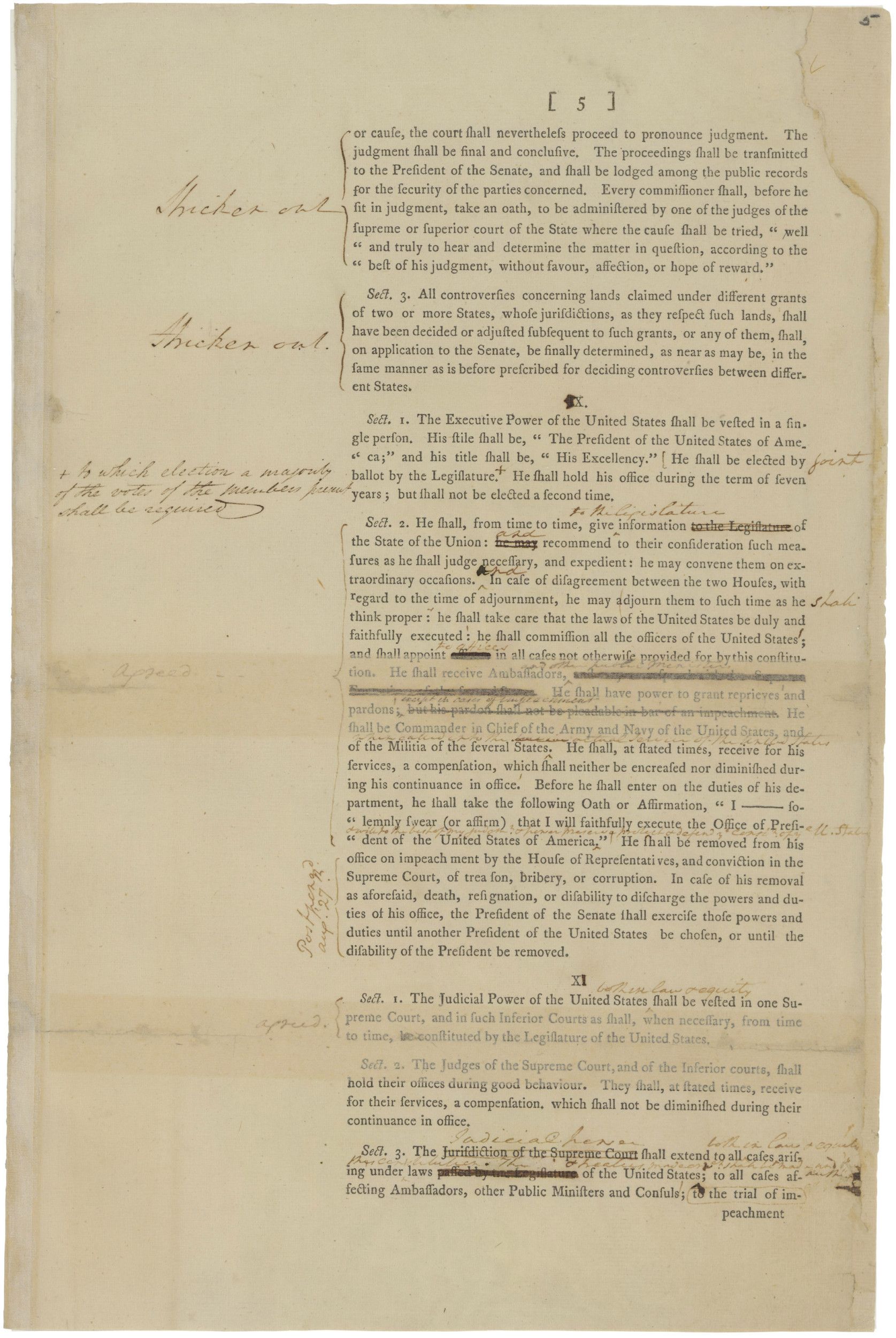
George Washington's Annotated Copy of a Draft of the U.S. Constitution
Page 6
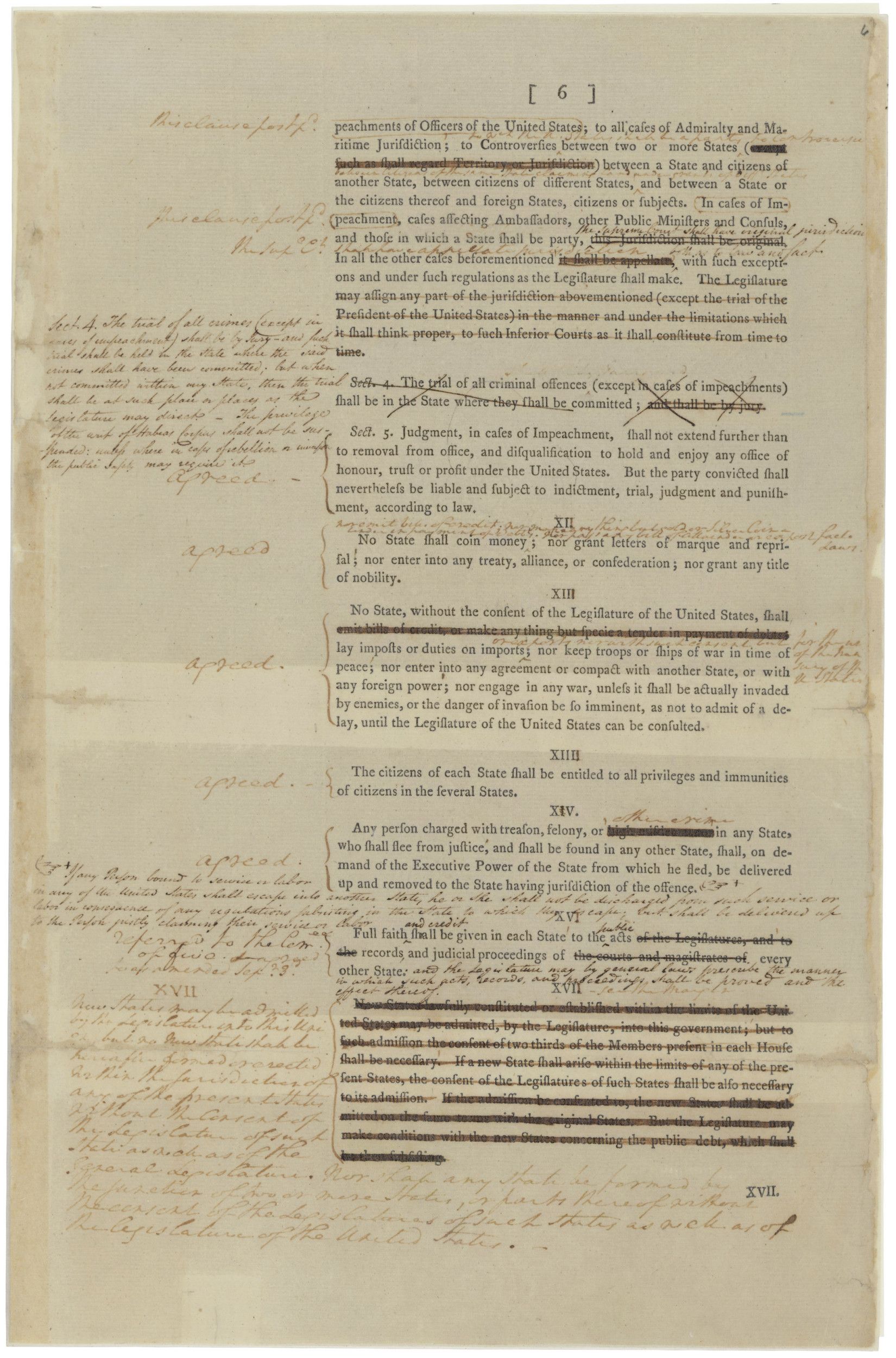
Document
[Printed version of the United States Constitution] Resolve Book of the Office of Foreign Affairs
9/28/1787
Th[e] volume [in which this document is bound] consists mainly of copies of orders and resolutions by the Confederation Congress with a few by the Senate of the First Federal Congress. Included are printed copies of "An Ordinance for the Regulation of Indian Affairs," 1786; "An Ordinance for the Government of the Territory of the United States Northwest of the River Ohio," 1787; the Constitution [images shown here]; and the acts establishing the Department of Foreign Affairs and the Department of State.
Additional details from our exhibits and publications
On September 17, 1787, the delegates to the Constitutional Convention completed their work and sent a signed parchment copy of the Constitution—along with hundreds of copies printed by John Dunlap and David Claypoole—to the Articles of Confederation Congress then meeting in New York. After further debate, the Confederation Congress sent the Constitution to the state legislatures, who would distribute them to ratifying conventions. The printed version shown here was printed on September 29, 1787, based on the type already set by the New York newspaper the Independent Journal. It was then placed in the Resolve Book of the Office for Foreign Affairs.
This primary source comes from the Records of the Continental and Confederation Congresses and the Constitutional Convention.
National Archives Identifier: 2316270
Full Citation: [Printed version of the United States Constitution] Resolve Book of the Office of Foreign Affairs; 9/28/1787; Records of the Continental and Confederation Congresses and the Constitutional Convention, . [Online Version, https://docsteach.org/documents/document/[printed-version-of-the-united-states-constitution]-resolve-book-of-the-office-of-foreign-affairs, April 16, 2024][Printed version of the United States Constitution] Resolve Book of the Office of Foreign Affairs
Page 1
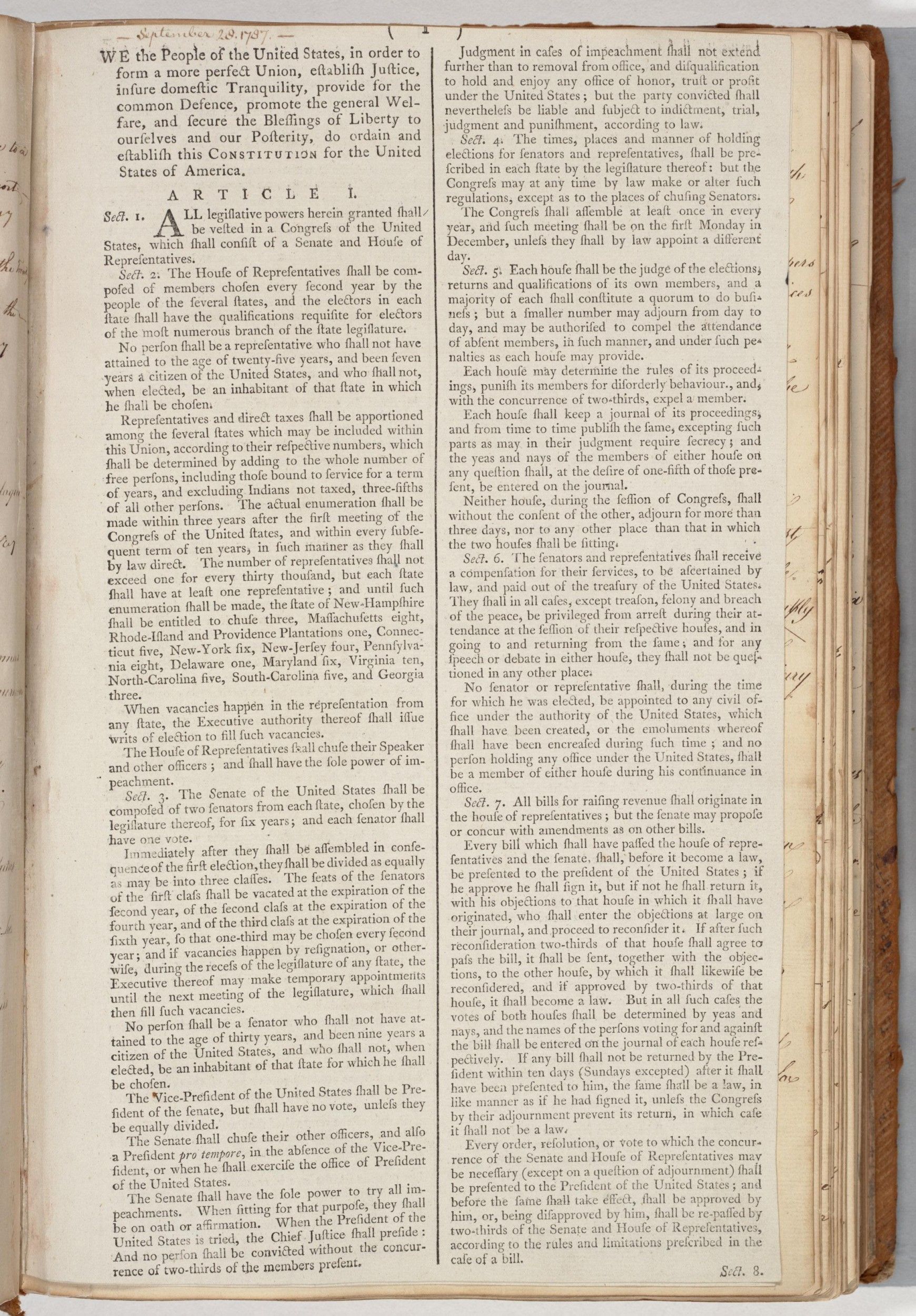
[Printed version of the United States Constitution] Resolve Book of the Office of Foreign Affairs
Page 2

[Printed version of the United States Constitution] Resolve Book of the Office of Foreign Affairs
Page 3

[Printed version of the United States Constitution] Resolve Book of the Office of Foreign Affairs
Page 4
